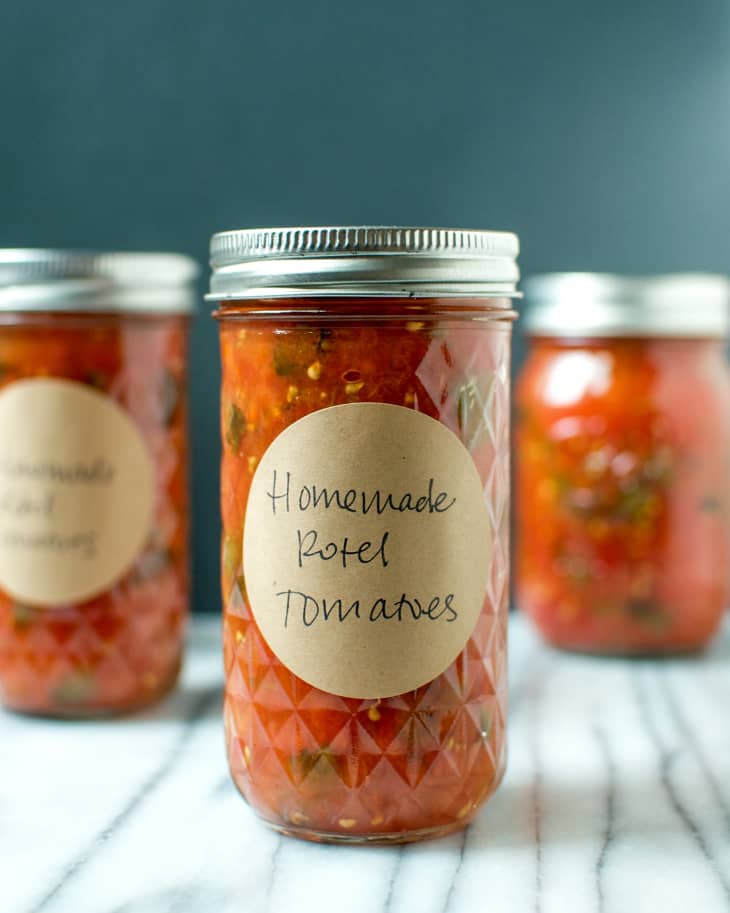Recipe: Rotel-Style Tomatoes

Rotel tomatoes are canned tomatoes with a little hint of heat. A Southern favorite, the spice comes from green chiles that have been fire-roasted, diced and stirred into the simmering tomatoes. Rotel tomatoes are a vital ingredient in queso and make a delicious addition to tortilla soup.
The only downside to developing a dependency on Rotel tomatoes is that they can often be tricky to find if you live north of the Mason Dixon line, like I do. So I take matters into my own hands and cook up a few jars for my pantry when tomatoes are in season.
Ideally, my homemade version would be made with Hatch chiles (they’re in season right now!). Sadly, they’re pretty hard to source in Philadelphia and so I use the easier to find poblano peppers. If you can get the slightly more delicious Hatch variety, I highly recommend them.
I like to use 12-ounce quilted jelly jars for this recipe because they hold nearly the same volume as you get in the Rotel can, but you can also process them in pints (there’s no difference in the boiling water bath time if you make that swap).
Are you a Rotel fan? What’s your favorite way to use them?
What’s Tomato Preserving 2.0?
When it comes to tomatoes, perhaps you’ve got the basics covered. You’ve made fresh tomato sauce, or roasted them, or thrown a bag in the freezer for easy peeling and sauce-making later. So what’s next?
This week Marisa McClellan of Food in Jars is guiding us through Tomato Preserving 2.0 — cooking lessons and good ideas for when you’re ready to move on to the next level of preserving tomatoes.
Learn the Basics
Rotel-Style Tomatoes
Makes 4 (12-ounce) jars
Nutritional Info
Ingredients
- 2
poblano peppers
- 5 pounds
Roma or paste tomatoes
- 8 tablespoons
bottled lemon juice
Instructions
Prepare a boiling water bath and 4 12-ounce jelly jars. Place lids in a small saucepan, cover them with water, and simmer over very low heat.
Preheat your broiler and line a rimmed baking sheet with aluminum foil. Place the poblano peppers on the baking sheet and roast under the broiler for 3 to 4 minutes. Once one side darkens and blisters, turn the peppers, until all sides are blackened. Remove peppers from oven and cover with another sheet of foil. Let them cool until you are able to handle them without burning yourself. Remove the skins and seeds and dice the peppers.
Bring a large pot of water to a boil. While it heats, remove the cores from your tomatoes and score the bottoms with a shallow "X." Fill a large bowl 2/3 the way with cold water and place near the stove.
Working in batches, blanch all your tomatoes for 1 to 2 minutes. Make sure to give the water a chance to come back up to boiling between batches. If the water isn’t hot enough, you will have a hard time removing the skin during peeling. As each batch is done, use a slotted spoon to transfer them to the bowl of ice water; the cold water stops the cooking and cools the tomatoes down enough for you to peel them.
Once all the tomatoes have been blanched and they are cool enough to touch, remove the skins.
Chop the peeled tomatoes and place them in a pot with as much of the tomato juices as you’re able to capture during the chopping process. Add the diced poblanos and bring to a boil. Cook at a controlled boil for 30 to 45 minutes to cook off some of the watery liquid, stirring regularly to prevent burning.
Take your prepared jars and add 2 tablespoons of bottled lemon juice to the bottom of each jar. Pour the hot chopped tomatoes into the jars, leaving 1/2 inch of headspace. Use a wooden chopstick to remove any air bubbles and adjust the amount of tomatoes if necessary.
Wipe the rims, apply lids and rings and process in a boiling water bath for 35 minutes.
When time is up, slide the pot off the hot burner and remove the lid. Let the jars cool gradually in the water for 10 minutes before lifting them out of the pot and setting them to cool on a folded kitchen towel. This step helps prevent the liquid loss that can occur when you rapidly change the temperature of your freshly processed jars.
When jars are completely cool, test the seals by pressing down on the lids. If they feel solid, the jars are sealed. If there’s any give or wiggle in the lids, they did not seal and should be refrigerated and used promptly.
